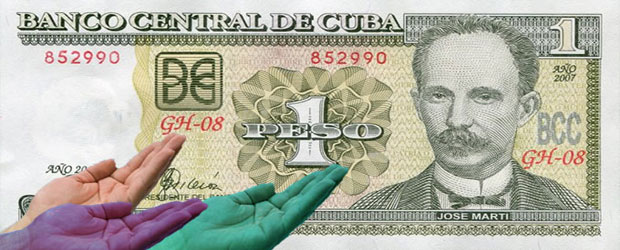
Dual currency and the producer/consumer
HAVANA – Many friends have communicated with me expressing interest in the announcement of a timetable to eliminate the monetary duality. They want to know. We all want to know. What can I add to what Progreso Semanal/Weekly reported on Oct. 22? Just a few details:
1. Most important is the official announcement of the existence of a timetable aimed at ending the dual currency, just as the item in Progreso Semanal/Weekly said.
2. The process will begin with the business system and continue with the cash liquidity of the population, guaranteeing Cubans that the value of their savings accounts will not be affected. I assume that the guarantee of value refers to the fact that, regardless of the exchange rate (or rates) imposed, the changes won’t affect those who keep convertible pesos (CUCs) in the bank, and the rate of 24 CUPs for 1 CUC will be respected.
3. The official note, I repeat, is the announcement of a process and the reaffirmation of the government’s will to carry it forward.
4. The Cuban peso (CUP) will be the only currency and its relation of 1 to 1, which is how it works in businesses, will be close to the CADECA [Exchange Bureaus] rate of exchange, i.e., 24 for 1.
5. “The official note does not provide details that might indicate the depth of the measure, nor does it say to which point the nominal devaluation of the type of exchange will be a real devaluation,” wrote to me the renowned Cuban academician Pavel Vidal, who is teaching at Xavierian University in Cali, Colombia.
Therefore, what’s essential is the announcement in and of itself. Let me add that already some companies are experimenting with a rate of exchange of 10 for 1. Let me repeat: trial balloons and caution are part of the gradual change, which is how the government works.
The foreign media and various news agencies are reporting the opinions of experts, from which I extract the key words: the reform is “inevitable,” it is “the greatest of reforms,” “much too difficult,” “bold,” “risky,” a “message to investors,” a sign of “an economy opening up to the market.” Obviously, the two last ones are attractive to mighty wallets.
Professor Vidal points to a relevant angle that I have not seen in other works. He says that “the correction in the type of exchange and the unification of currencies will make more transparent the cash balances of business companies and will clarify the national accounts and the State budget.
“Also, it will make clear that monetary duality is not responsible for the low purchasing power of the wages or the inequalities, which are structural – not monetary – issues,” Vidal writes. If that is so (something I don’t doubt, given the academician’s caliber), the measure would lead to a strengthening of the policy of reforms and actualizations. A blow to craftiness.
Evidently, the descriptions of a risky and bold decision (both true) are navigating through the Web and appear in several headlines. Throughout Cuba, many doubts have been voiced as to how monetary unification will be applied and if indeed it will be carried out. This morning, two ladies buying bread at a street-corner bakery talked about the issue.
“I don’t know if I’ll be alive when that time comes,” said one. The other predicted that the changeover would come “late, badly and maybe never.”
The other duality: the producer/consumer
The fact is that reality, always stubborn, imposes itself and the boldness needed to make the move is unavoidable, because the decision has political implications that have a bearing on national security and the health of the process of changes.
To eliminate the monetary duality – which is one of the causes (not the single cause) of corruption, the deflection of resources, and other ills that we’ve been suffering for years – becomes the key to the development of the required transformations.
By definition, each of us human beings has a dual condition: we are simultaneously producers and consumers. If our capacity to consume goods and services exceeds their production, or if we don’t produce those goods, the integrated balance is broken and the individual loses his incentive, beginning (as he began years ago) a vicious circle that feeds upon itself: “I do not produce because I don’t receive a wage with purchasing power;” “What I receive is worthless to me as consumer.” The result is that the “me as producer” becomes depressed and loses his motivation.
The result is a chaotic economy, a dissatisfied citizen, a distancing between the rulers and the ruled, between the project and its makers, the people. The vicious circle feeds on the Empire’s persistent policy of encirclement that heats up the famous pressure cooker. To the Empire, a distancing is the step prior to a divorce, to a breakup. And a broken man does not build a nation or lives within a reality that is meaningless, that does not empower him.
The process of transformations demands a rare and difficult combination of boldness and calculation. It rejects unnecessary restraints. Today’s Cuban is much more complex than anyone might assume. He aspires to a society as complex as he is, where he can play a leading role and have the capacity to scrutinize data and policies. To reestablish the producer/consumer harmony, the nation must deal with the peso issue.
Progreso Semanal/ Weekly authorizes the total or partial reproduction of the articles by our journalists, so long as source and author are identified.

